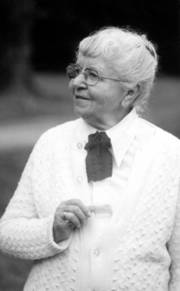
Gurdjieff International Review
Again—The Work in Life
A. L. Staveley
When I hear the expression “The Work in Life” what is my inner experience? This is worth investigating for the sake of the survival of the work. I can so easily relapse into some kind of fantasy in which I dream of myself expounding the ideas to an attentive crowd who are finally able to defer to my superior experience and knowledge; or I see myself defending the ideas, startling everyone with my acuteness, my grasp of basic ideas and the ability to expound them—and so on.

But none of it is any good, is it? The Work in Life is very real. It is my very own work that has to go into life—my work on myself. How I am. Not my words, not my behavior, though these accompany me and may possibly be results of how I am, but something almost intangible and at the same time very real. I cannot intend it, or plan it, or project it. In fact, in an odd sort of way, whatever I have truly done in the way of work on myself belongs to the work and not to me and I must permit it to be so. I must be like a well-tuned instrument or a sharpened tool, ready to be used—how is not always quite clear. One of our fears today is the fear of being used—but I must learn my function by finding how the work and life can use me.
This is the basic atom without which “Work in Life” is a meaningless phrase. Self-development, self-change. I am not at all trying to prove something. At the same time I am a proof. What I am, is, and is with me always. What I do and the products and results of what I do are always in life—whether on the mountain top or in the market place it is all the same. What I do is stamped in the intangible way mentioned above with how I am. I cannot myself assess this and should not try, for when I assess, it is my mind, the ego, trying to access. The measure by which the higher levels measure is as yet unknown to me and my everyday values are all suspect. What seems trivial and small to me may be the very reverse when seen from above. In any case, as we are reminded again and again, this is where I must begin—with small things.
Take awareness. To become more aware is part of my work of awakening. We talk about it, perhaps dream about it but my awareness, if any, will manifest itself in the practical work I do. Do I tread obliviously on the new baby plants struggling to survive? Is the path behind me strewn with my disorder? Do I ever notice when lights are on unnecessarily? Doors left to slam? How sensitive am I to someone else’s state—their need? Am I wasteful in the use of materials? Can I estimate exactly how much of anything is needed—soap, paint thinner, fertilizer, pressure on a tool or sandpaper, the time needed for washing dishes?
There is no area in which the practice of awareness should not be an integral part. Can you wrap a package like a professional? Carve a roast with no waste? Prune a tree in the best interests of a tree? Write a letter which says exactly what you want it to? Opportunities in life for the practice of awareness are endless. And be sure that when anyone struggles to be more aware, the results of that struggle will appear in the product of his task, be it large or be it small. Ego sets up a trap just here. Knowing that these results appear, I may find myself at times trying to prove I am aware by doing something in a meticulous way. I have to recognize the taste of this which is very different from real awareness which comes with perseverance and effort, and often has no reward from outside—maybe even some suffering. The kind of suffering that comes from trying something which seems impossible at first.
It might be a good plan today to make the effort to notice—really to acknowledge, at least to myself—how much around me I am not aware of. And how something intractable in me is opposed to awareness and awakening. The Work in Life—for me—will depend on the outcome of the battle.
~ • ~
This excerpt is taken from Mrs. Staveley’s book Themes II, Aurora, OR: Two Rivers Press, 1982, pp. 102–103, and is used here with the kind permission of Two Rivers Farm.
| Copyright © 2007 Gurdjieff Electronic Publishing Featured: Spring 2007 Issue, Vol. X (1) Revision: April 1, 2007 |